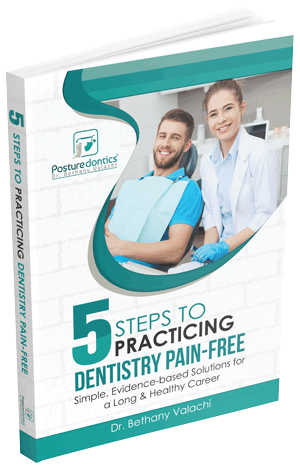Pain is not a necessary by-product of dentistry. You can reduce or eliminate your pain with targeted, evidence-based interventions!
VIEW VIDEO
Access the WellBody System NOW!
Unfortunately, most dental and hygiene schools do not teach evidence-based ergonomics and wellness strategies. To make matters worse, the dental continuing education system is flooded with outdated, hand-me-down ergonomic education and inaccurate, sponsor-driven education that is creating a pain epidemic in the industry.
Effectively resolving work-related pain in dentistry requires correctly identifying the risk factors, and then targeting those risk factors with specific, evidence-based interventions. Due to the multi-factorial nature of work-related pain, rarely does a single intervention (i.e. purchasing a new set of loupes, strength training) permanently resolve pain issues.
It is also important to know the proper sequence in which to implement the interventions. Here are my 5 Steps to Practicing Dentistry Pain-free to help you work with less pain, improve your quality of life and extend your career.
STEP 1. ‘ERGONOMIZE’ YOUR OPERATORY. Imagine spending $1500 on a pair of dental loupes, only to discover they are creating your neck pain! If you invest in non-ergonomic equipment, you only have 2 choices: live with it or buy more equipment–neither is a good option. Resolving ergonomics in your operatory is the first and foremost step in addressing work-related pain in dentistry, as it is often the etiology of the problem.
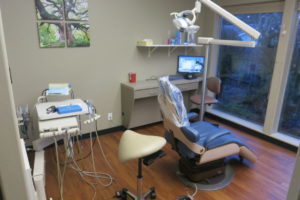
Some important questions to ask:
- How can I economically make ergonomic modifications to my operatory?
- How should I adjust the seat on my operator stool to prevent low back pain?
- Is my loupe declination angle improving or hurting the health of my neck?
- Does a backrest help prevent back pain?
- Where should my delivery system be positioned to prevent shoulder pain?
- What is the best clock position to treat my patients?
For example: One of the most common ergonomic mistakes I observe is TTL loupes with a poor declination angle that forces the operator into an unsafe forward head posture and causes neck pain. I have found that there is only one style of loupe on the market that consistently keeps all operators in a safe head posture.
Before you invest in ergonomic equipment, it is helpful to know which stools, loupes, instruments, gloves, delivery systems and chairs will benefit your health and not make it worse! The WellBody System for Dental Professionals walks you step-by-step through how to select and adjust the proper stool for your height, weight, job, spinal curvature and gender. It provides evidence-based guidelines to selecting truly ergonomic loupes, delivery systems, and more, to enable you to work safely and comfortably.
STEP 2. MANAGE YOUR STRESS. Have you ever wondered why certain muscles get sore when you’re stressed out? Especially the upper trapezius or low back muscles? There is a reason for this! From our earliest hunter-and-gatherer days, we are still hard-wired for the fight-or-flight response (via the sympathetic nervous system), which preferentially shunts blood from the small postural muscles to the larger ‘mover’ muscles . This response may have proven life-saving thousands of years ago, but may not serve you as well in a stressful clinical situation! When your nervous system is in overdrive, the small postural stabilizing muscles are not “as important” as the larger mover muscles and become deprived of oxygen, ischemic and painful. Dental professionals must employ specific evidence-based strategies that down-regulate the sympathetic nervous system and prevent stress induced pain syndromes.
For example: Shallow ‘chest breathing’ is a common breathing pattern in the dental operatory, which further deprives ischemic postural muscles of oxygen. Shallow breathing can up-regulate your sympathetic nervous system, heightening your body’s stress response. Low back and sacro-ioliac pain can also result from sub-optimal breathing patterns. Correcting this breathing and pain pattern is just one of four key stress management strategies taught in the WellBody System for Dental Professionals.
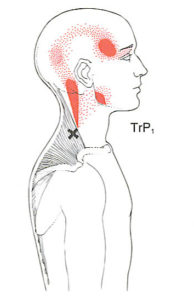
STEP 3. RESOLVE YOUR TRIGGER POINTS. Have you ever experienced a headache behind your eye that isn’t resolving with pain meds? It’s likely coming from trigger point #1 in your upper trapezius muscle! Unfortunately, trigger points are often overlooked in traditional Western medicine and dental professionals are sent from specialist to specialist with no resolution to their pain. Trigger points refer pain to a distant area of the body and are common among dental operators due to body asymmetry, poor postures, poor body mechanics, repetitive movement, lack of movement, sustained muscle contraction and mental stress. It is important to relieve trigger points as soon as possible to restore nutrient flow to the muscle, prevent muscle imbalances and prevent compression on nerves. Strengthening muscles with trigger points will often make your pain worse!
For example: Pain in the medial border of the shoulder blade is usually referred pain that comes from one of the 7 key trigger points to which dental professionals are prone. The actual trigger point is actually no where near the scapula!
There are various methods to treat trigger points, however due to costs, time constraints or convenience, self-treatment is often the most practical and economical consideration. The WellBody System for Dental Professionals instructs you in how to perform self-myofascial release on 7 key trigger points to which dental professionals are prone.
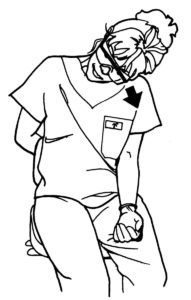
STEP 4. DEVELOP GOOD FLEXIBILITY. Have you noticed you are tighter on one side than the other? Muscle imbalances are very common among dental professionals and can lead to neuromuscular, joint and spine disorders. Chairside stretching is imperative to correct these imbalances, regain full range of motion and prepare you for strengthening. Overstretching muscles with active trigger points may cause micro-tearing of muscle, which is why stretching is recommended after trigger point treatment. Since dental professionals are prone to muscle imbalances, it is important to ensure you are targeting the correct muscles with your stretching. Rather than stretching muscles that are already elongated, focus on the muscles that tend to become short, tight and ischemic. Chairside stretches are especially for men, who are more prone to musculoskeletal injury due to poor flexibility than women.
For example: Tight chest (pectoralis muscles) and scalene muscles are very common among dental professionals and can compress the brachial plexus, causing arm & hand pain and numbness–mimicking carpal tunnel syndrome!
The WellBody System for Dental Professionals provides you with 20 chairside stretching exercises that target the tight, ischemic muscles to which dental professionals are prone.
View video: Why Dental Professionals Require Specific Exercise
STEP 5. STRENGTHEN SPECIFIC STABILIZING MUSCLES. Have you ever hired a personal trainer or started a Pilates or Crossfit routine only to find your pain got worse? Dental professionals are prone to unique muscle imbalances. Exercises that are not a problem for the general public can throw dental professionals into ‘the vicious pain cycle’. This is why all strengthening exercise is not necessarily good exercise for dental professionals.
If you strengthen muscles with trigger points, your pain may worsen, which if why this is the 5th step in our sequence. Wait until the area is pain-free and you have full range of motion before you begin strengthening.
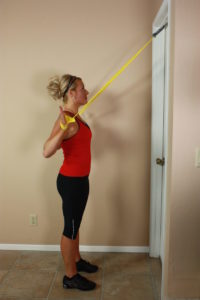
Studies show that dentists with better endurance of the back and shoulder girdle muscles have less musculoskeletal pain. Because of their vulnerability to muscle imbalances, the exercise needs of dental professionals are very specific, and while certain key muscle groups should be targeted, others should be very cautiously approached or eliminated altogether in an exercise regimen. Dr. Valachi created 3 routines with 24 exercises in the WellBody System for Dental Professionals to correct these painful muscle imbalances that can lead to musculoskeletal disorders and injury. A fusion of evidence-based exercises for back pain, neck pain, yoga, physical therapy and Pilates, each exercise has a specific application in the dental operatory to prevent pain.
For example: Strength training the upper trapezius muscle is one of the easiest ways to put yourself on the fast track to neck pain! The upper trapezius muscle is the most actively used muscle in dentistry and also the most vulnerable to pain. It easily develops a painful ischemia–performing an anaerobic exercise on it is one of the worst interventions dental professionals can perform.
Ensuring a pain-free career involves addressing numerous risk factors. Remember, that implementing only one step rarely resolves pain completely.
Learn how to implement all 5 steps to resolve your work-related pain:
CLICK HERE
©2020 Posturedontics, LLC. All rights reserved.

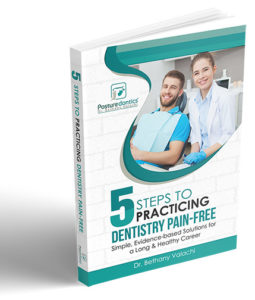 How can you protect your back, neck, shoulders, and hands for a long and healthy career?
How can you protect your back, neck, shoulders, and hands for a long and healthy career?

